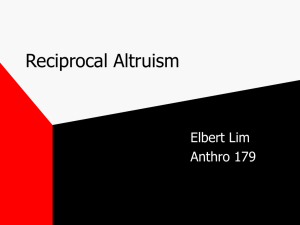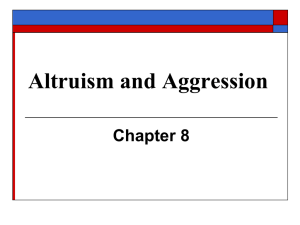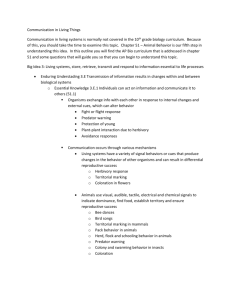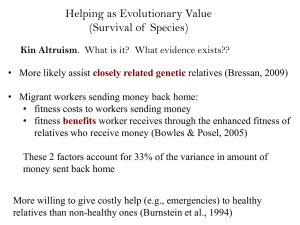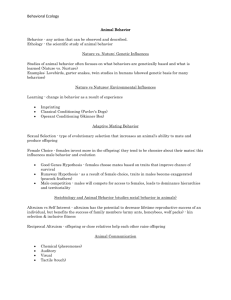Sociality and social behaviour
advertisement
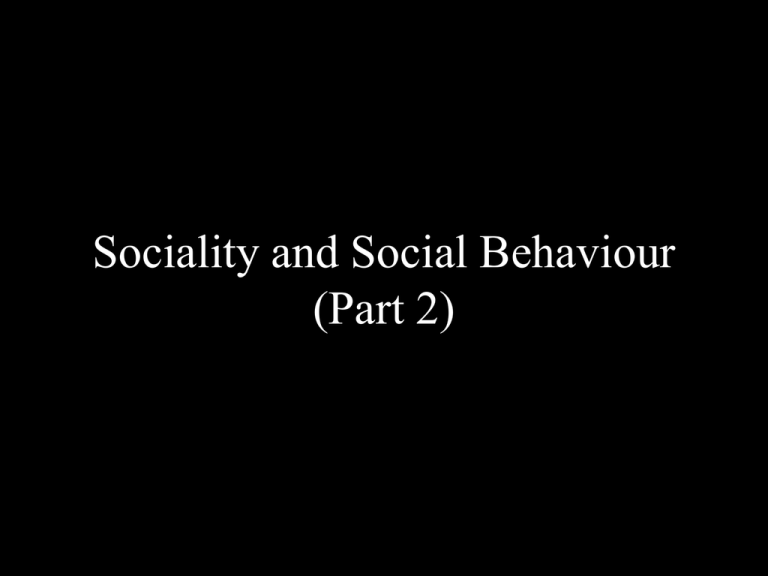
Sociality and Social Behaviour (Part 2) Altruism by non-relatives Reciprocity - incur a cost now in anticipation of receiving a benefit later Modelling - use Game Theory - John Nash Altruism by non-relatives Prisoner’s Dilemma 2 prisoners - caught and jailed for a petty crime - suspected of having committed a more serious crime Altruism by non-relatives Prisoner’s Dilemma Each prisoner (player) has a choice cooperate - deny all knowledge of the serious crime defect - accuse the other of the more serious crime Reward for defecting - forgiven minor crime Altruism by non-relatives Prisoner’s Dilemma Each strategy has a payoff Payoff depends on behaviour of the opponent 1. Both cooperate - both get a reward - R 2. Both defect - both get punished - P 3. One cooperates & one defects - defector set free - T (temptation payoff) - cooperator jailed - S (sucker’s payoff) Altruism by non-relatives Prisoner’s Dilemma This relationship of payoffs must hold T > R > P > S Temptation > Reward > Punishment > Sucker’s Altruism by non-relatives Maximum sentence - 12 years (10 for major, 2 for minor) What are the years saved by each strategy? Player B Plays first Cooperate Defect Player A Cooperate R = 10 S=0 Defect T = 12 P=2 Altruism by non-relatives Prisoner’s Dilemma How should they behave? -should defect - always saves something Player A -if B cooperates - T > R -if B defects - P > S Player B If both defect do worse than if they cooperate R > P Altruism by non-relatives Prisoner’s Dilemma How should they behave? After a number of simulations with more than one move, Best strategy is a tit-for-tat -cooperate on first move and then do what opponent did on previous move Altruism by non-relatives Prisoner’s Dilemma Benefits of tit-for-tat 1. Initially cooperative 2. Quick to retaliate 3. Quick to forgive Altruism Does this work in nature? Kin Selection Reciprocity Altruism Kin Selection - in mate acquisition Wild turkeys - male progeny of a single brood - group for life -dominance hierarchy - only dominant male mates Altruism Kin Selection - in mate acquisition Reproductive success of non-mating males -realized through RS of brother How? If brother mates with four females -non-maters RS = 4 x relatedness x .5 (to account for female’s contribution) = 4 x 0.5 x 0.5 = 1.0 Altruism Reciprocity - in mate acquisition Long tailed manakins Altruism Reciprocity - in mate acquisition Long tailed manakins - only dominant male mates Courtship dance Subordinate Dominant Altruism Reciprocity - in mate acquisition Does subordinate male assume role of dominant? predicted • • • Copulations per hour: New alpha male • • • observed • • Copulations per hour: previous alpha male Altruism Reciprocity - in mate acquisition Why have 2 males? - females are attracted to 2-male courtship groups Altruism Reciprocity - in predator detection Meerkats - sentinels Altruism Reciprocity - in predator detection Meerkats - sentinels -forage in groups - not related -every so often - one animal stands to look for predators -sentinel warns of approaching predator Altruism Reciprocity - in predator detection Meerkats - sentinels This behaviour is adaptive if: Chance of being preyed on while acting as a sentinel < Survivorship while others are sentinels Altruism Reciprocity - in predator detection But is this really reciprocity? Alternative hypothesis (selfish): “Sentinels” are really just animals who have finished feeding and are looking for predators to protect themselves. Altruism But is this really reciprocity? Some predictions from reciprocity hypothesis: Prediction Observation Regular rotation of sentinel duty Sentinel duty appears to be haphazard Sentinel duty has risk of succumbing to predator Sentinels are usually closer to an escape burrow Less time is spent in predator detection in groups No difference in sentinel time when solitary
